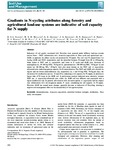Please use this identifier to cite or link to this item:
http://www.alice.cnptia.embrapa.br/alice/handle/doc/940939| Title: | Gradients in N-cycling attributes along forestry and agricultural land-use systems are indicative of soil capacity for N supply. |
| Authors: | FAGOTTI, D. S. L.  MIYAUCHI, M. Y. H.   OLIVEIRA, A. G.   SANTINONI, I. A.   EBERHARDT, D. N.   NIMTZ, A.   RIBEIRO, R. A.   PAULA, A. M.   QUEIROZ, C. A. S.   ANDRADE, G.   ZANGARO, W.   NOGUEIRA, M. A.   |
| Affiliation: | Universidade Estadual de Londrina- UEL.; Universidade de São Paulo - USP; Universidade Estadual de Londrina - UEL.; Universidade Estadual de Londrina - UEL.; Universidade de São Paulo - USP.; Universidade Estadual de Londrina - UEL.; Universidade Estadual de Londrina - UEL.; Universidade de São Paulo - USP.; Universidade Estadual de Londrina - UEL.; Universidade Estadual de Londrina - UEL.; Universidade Estadual de Londrina - UEL; MARCO ANTONIO NOGUEIRA, CNPSO. |
| Date Issued: | 2012 |
| Citation: | Soil Use and Management, Oxford, v. 28, n. 3, p. 292-298, Sept. 2012. |
| Description: | Indicators of soil quality associated with N-cycling were assessed under different land-use systems (native forest ? NAT, reforestation with Araucaria angustifolia or Pinus taeda and agricultural use ? AGR) to appraise the effects on the soil potential for N supply. The soil total N ranged from 2 to 4g⁄ kg (AGR and NAT, respectively), and the microbial biomass N ranged from 80 to 250 mg⁄ kg, being higher in NAT and A. angustifolia, and lower in P. taeda and AGR sites. Activities of asparaginase (ca. 50?200 mg NH 4 + -N ⁄ kg per h), glutaminase (ca. 200?800 mg NH -N ⁄ kg per h) and urease (ca. 80?200 mg NH -N ⁄ kg ⁄ h) were also more intense in the NAT and A. angustifoliareforested soils, indicating greater capacity for N mineralization. The NAT and AGR soils showed the highest and the lowest ammonification rate, respectively (ca. 1 and 0.4 mg NH 4 + -N ⁄ kg per day), but the inverse for nitrification rate (ca. 12 and 26%), indicating a low capacity for N supply, in addition to higher risks of N losses in the AGR soil. A multivariate analysis indicated more similarity between NAT and A. angustifolia-reforested sites, whilst the AGR soil was different and associated with a higher nitrification rate. In general, reforestation with the native species A. angustifolia had less impact than reforestation with the exogenous species P. taeda, considering the soil capacity for N supply. However, AGR use caused more changes, generally decrease in indicators of N-cycling, showing a negative soil management effect on the sustainability of this agroecosystem. |
| Thesagro: | Solo Qualidade Nitrificação Amonificação |
| NAL Thesaurus: | Soil quality Nitrification Ammonification |
| DOI: | 10.1111/j.1475-2743.2012.00418.x |
| Type of Material: | Artigo de periódico |
| Access: | openAccess |
| Appears in Collections: | Artigo em periódico indexado (CNPSO)  |
Files in This Item:
| File | Description | Size | Format | |
|---|---|---|---|---|
| 2012SUMV28p292298Fagotti.pdf | 2.67 MB | Adobe PDF |  View/Open |









